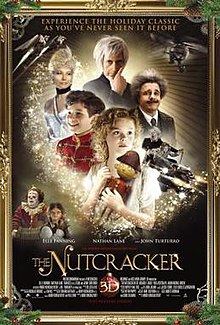The Nutcracker in 3D
| The Nutcracker in 3D | |
|---|---|

Theatrical release poster
|
|
| Directed by | Andrei Konchalovsky |
| Produced by |
|
| Screenplay by |
|
| Based on |
The Nutcracker by Pyotr Ilyich Tchaikovsky and The Nutcracker and the Mouse King by E.T.A. Hoffman (uncredited) |
| Starring | |
| Music by | Eduard Artemyev |
| Cinematography | Mike Southon |
| Edited by |
|
|
Production
company |
|
| Distributed by |
|
|
Release date
|
|
|
Running time
|
110 minutes |
| Country |
|
| Language | English Hungarian |
| Budget | $90 million |
| Box office | $16.2 million |
The Nutcracker in 3D (released on DVD as The Nutcracker: The Untold Story) is a 2009 British-Hungarian 3D Christmas fantasy film adaption of the ballet The Nutcracker, directed by Andrei Konchalovsky. The film was met with negative reviews from critics upon its release, and was a box office bomb. The film does not credit the original The Nutcracker and the Mouse King story, nor its author E. T. A. Hoffmann.
Mary's (Elle Fanning) seemingly dull Christmas is suddenly filled with excitement and adventure following the arrival of her Uncle Albert (Nathan Lane), who gives her a Nutcracker as a gift. Later that night, Mary dreams that the Nutcracker—called N.C. (Charlie Rowe)--comes to life and takes her on a wondrous journey. They discover that the Nazi-like Rat King (John Turturro) has usurped the Nutcracker's kingdom.
In the climax of the film, the Nutcracker appears to have been killed, but Mary's tears and declaration of love restore him to life and transforms him into a prince, his true form. The rats are all defeated and overthrown, but now Mary must reluctantly awaken from her dream. Before she's fully awake, N.C. promises that they'll meet again. After she does so, she goes to Uncle Albert's workshop, where she meets his new young neighbor, who is the exact image of the Nutcracker Prince and who asks to be called N.C. The two become close friends, and the last shot of the film shows them ice skating together.
Director Konchalovsky stated that The Nutcracker in 3D had been his "dream project" for over 20 years. Konchalovsky was inspired to adapt the film into 3D for several reasons; he believed that the format would be useful in conveying the fantastical nature of the material, capturing the emotions of CGI characters, and appealing to a family audience. At the same time, he opted to adapt the film with no ballet sequences because, according to him, "ballet cannot work in cinema very well."
...
Wikipedia
